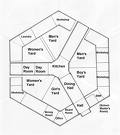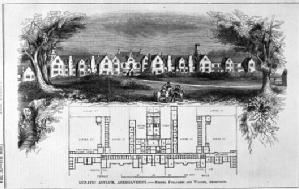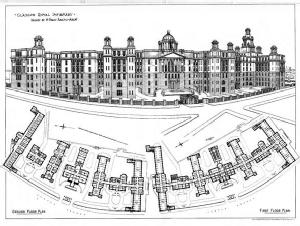Welfare and Institutions
Key Texts
- Keir Waddington, 'Health and medicine', in Chris Williams (ed.), Companion to Nineteenth-century Britain
- Marguerite Dupree, 'The provision of social services', in Martin Daunton (ed.), Cambridge Urban History of Britain, vol 3
- R. Adair, B. Forsythe and J. Melling, ‘A Danger to the Public? Disposing of Pauper Lunatics in Late-Victorian and Edwardian England: Plympton St Mary Union and the Devon County Asylum, 1867-1914’, Medical History, 42 (1998)
- Felix Driver, ‘The Historical Geography of the Workhouse System in England and Wales, 1834-1883’, Journal of Historical Geography, 15 (1989)
-
A. Scull, ‘Museums of Madness Revisited’, Social History of Medicine, 6 (1993)
-
Leonard Smith, ‘The Pauper Lunatic Problem in the West Midlands 1818-1850’, Midland History, 21 (1996)
- Peter Higginbotham's Workhouse website
Seminar Questions
- Why did the Victorians turn to institutions to solve their social/medical problems? How successful were these institutions?
- How important was the architecture of the institutions in determining their purpose?
- Were hospitals more successful at killing than curing their patients?
- 'Pauper palaces' or akin to the 'Bastille' - which description of Victorian workhouses is more accurate?
- Were asylums a place to 'dispose' of inconvenient people in the Victorian period?
Further Reading
P. Bartlett, The Poor Law of Lunacy: The Administration of Pauper Lunatics in Mid-Nineteenth-Century England
A. Borsay, Medicine and Charity in Georgian Bath: A Social History of the General Infirmary, c. 1739-1830
S. Cherry, ‘The Hospitals and Population Growth: The Voluntary General Hospitals, Mortality and Local Populations in the English Provinces in the Eighteenth and Nineteenth Centuries’, Part 1 and Part 2, Population Studies, 34 (1980)
Frank Crompton, Workhouse Children: Infant and Child Paupers Under the Worcestershire Poor Law 1781 -1871
M. A. Crowther, The Workhouse System 1834 -1929: The History of an English Social Institution
Anne Digby, Pauper Palaces
Simon Fowler, The Workhouse: the People, the Places, the Life Behind Doors
Nigel Goose, ‘Workhouse Populations in the Mid Nineteenth Century: the Case of Hertfordshire’, Local Population Studies, 62 (1999)
L. Granshaw and R. Porter (eds), The Hospital in History
L. Granshaw, ‘The Rise of the Modern Hospital in Britain’, in A. Wear (ed.), Medicine in Society: Historical Essays
Andrew Hinde and Fiona Turnbull, ‘The Populations of Two Hampshire Workhouses 1851–1861’, Local Population Studies, 61 (1998)
Steven King, Poverty and Welfare in England, 1700-1850: a Regional Perspective
Norman Longmate, The Workhouse
L. Marks, ‘Medical Care for Pauper Mothers and Their Infants: Poor Law provision and Local Demand in East London, 1870-1929’, Economic History Review, 46 (1993)
J. Melling and B. Forsythe (eds), Insanity, Institutions and Society, 1800-1914
J. Melling, B. Forsythe and R. Adair, ‘Families, Communities and the Legal Regulation of Lunacy in Victorian England: Assessments of Crime, Violence and Welfare in Admissions to the Devon Asylum, 1845-1914’, in P. Bartlett and D. Wright (eds), Outside the Walls of the Asylum: The History of Care in the Community 1750-2000
Kathryn Morrison, The Workhouse: a Study of Poor Law Buildings in England
W. Ll. Parry-Jones, The Trade in Lunacy: A Study of Private Madhouses in England in the Eighteenth and Nineteenth Centuries
J.V. Pickstone, Medicine and Industrial Society: A History of Hospital Development in Manchester and its Region 1752-1946
R. Porter, ‘Madness and its Institutions’, in A. Wear (ed.), Medicine in Society: Historical Essays
G. Risse, Hospital Life in Enlightenment Scotland: Care and Teaching at the Royal Infirmary of Edinburgh
E. M. Sigsworth, ‘Gateways to Death? Medicine, Hospitals and Mortality, 1700-1850’, in P. Mathias (ed.), Science and Society 1600-1900
L. Smith, ‘”To Cure those Afflicted with the Disease of Insanity”: Thomas Bakewell and Spring Vale Asylum’, History of Psychiatry, 4 (1993)
L. Smith, 'Cure, Comfort and Safe Custody': Public Lunatic Asylums in Early Nineteenth-Century England
L. Smith, Lunatic hospitals in Georgian England, 1750-1830
A. Scull, The Most Solitary of all Afflictions: Madness and Society in Britain, 1700-1900
A. Scull, Museums of Madness: The Social Organization of Insanity in nineteenth century England
K. Waddington, Charity and the London Hospitals, 1850-1898
J. Walton, ‘The Treatment of Pauper Lunatics in Victorian England: The Case of Lancaster Asylum, 1816-70’, in A. Scull (ed.), Madhouses, Mad-Doctors, and Madmen: The Social History of Psychiatry in the Victorian Era
Peter Wood, Poverty and the Workhouse in Victorian Britain
J. Woodward, To Do the Sick No Harm: A Study of the British Voluntary Hospital System to 1875
D. Wright, ‘The Certification of Insanity in Nineteenth-Century England and Wales’, History of Psychiatry, 9 (1998)



